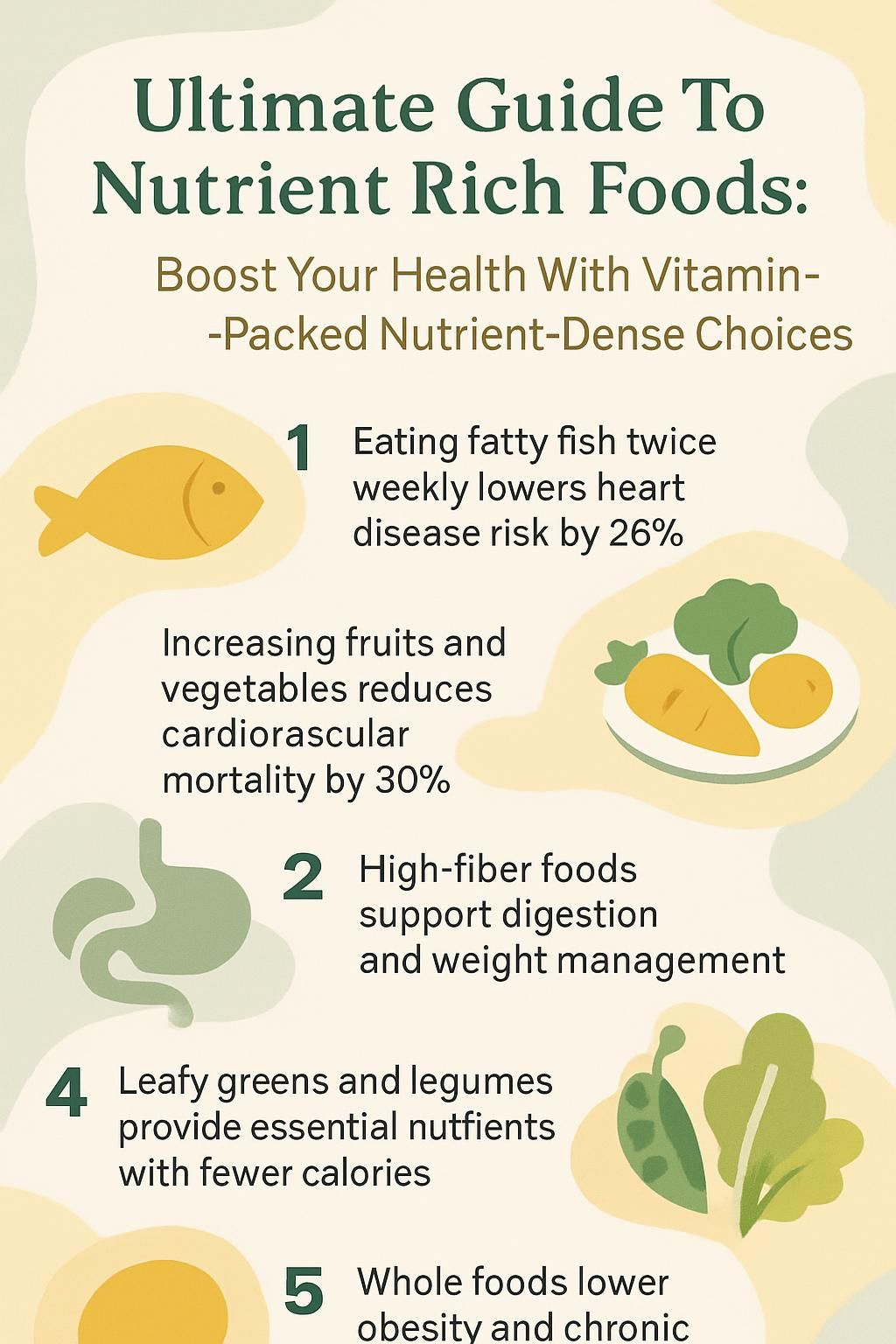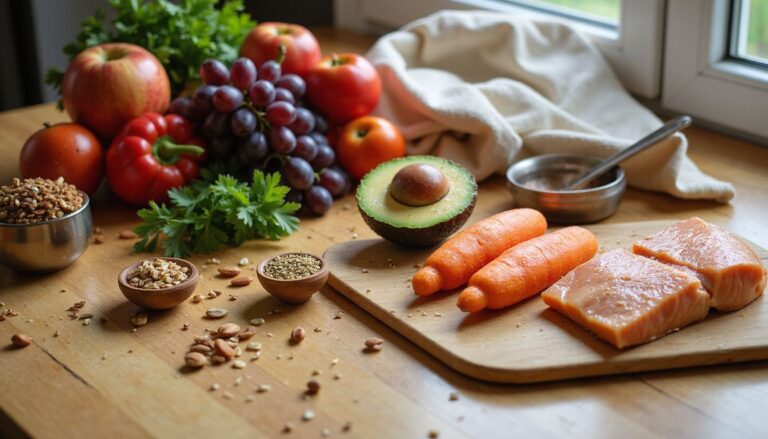Ultimate Guide To Nutrient Rich Foods: Boost Your Health With Vitamin-Packed Nutrient-Dense Choices
Our Nutrition Assistant AI Suite will transform your body. You will lose fat, get toned, and build muscle. Gain confidence and optimal health.
Eating healthier can feel confusing at first. I struggled too, until I focused on nutrient-dense foods that pack vitamins and minerals into every bite. These choices helped me feel steady energy and stronger immunity throughout the week.
After digging into the research, I learned that healthy eating can be simple. This guide shows how nutrient-rich foods support your body, which key nutrients to seek, and easy ways to build a balanced diet with fruits, vegetables, whole grains, lean meats, nuts, and legumes. Once you know where to start, healthier meals feel easier day after day.
Key Takeaways
- Nutrient-dense foods like leafy greens, salmon, berries, eggs, nuts, and legumes deliver essential vitamins and minerals with fewer calories.
- The American Heart Association reports that eating fatty fish twice a week may lower heart disease risk by up to 25% (2021).
- High-fiber foods such as whole grains and legumes support digestion, steady energy, and weight control, according to Harvard T.H. Chan School of Public Health.
- Studies link higher fruit and vegetable intake with up to 30% lower cardiovascular mortality risk (Nutrients 2020; American Journal of Clinical Nutrition 2022).
- Choosing whole foods over processed snacks is tied to lower obesity rates and lower chronic disease risk in U.S. adults, per CDC data from 2021.

Overview of Nutrient-Rich Foods

Nutrient-rich foods supply a wide range of vitamins and minerals that support health. They raise the nutritional value of each meal and encourage steady, healthy habits.
What are nutrient-dense foods?
Nutrient-dense foods give you many vitamins and minerals for relatively few calories. They also provide dietary fiber, protein, and healthy fats with little added sugar or saturated fat.
A cup of kale contains vitamin K and helpful antioxidants such as lutein and zeaxanthin. These compounds help protect cells from damage.
Eating for nutrients helps me feel my best every day.
I try to add colorful fruits and vegetables to most meals for their micronutrients. Salmon, eggs, beans, yogurt, whole grains like quinoa or brown rice, and nuts such as almonds or chia seeds deliver a broad mix of vitamins and minerals. This approach covers more needs across food groups in a simple, practical way.
Why are nutrient-rich foods important for health?
Nutrient-rich foods support growth, repair, and a strong immune system. Options like fruits, vegetables, lean cuts of meat, and dairy foods help keep cholesterol and blood sugar in healthy ranges.
Research from the American Heart Association links nutrient-dense eating patterns with lower risk of cardiovascular disease and type 2 diabetes. Choosing foods rich in vitamin C, B vitamins like B6 and B12, omega-3 fatty acids from fish, potassium from potatoes or bananas, iron from legumes, and zinc from seafood or nuts can raise diet quality. I maintained a healthy weight after teen obesity by focusing on these foods, and the difference has lasted.
What Are the Benefits of Eating Nutrient-Dense Foods?
Eating nutrient-dense foods builds healthy habits and helps maintain a healthy diet. People who center meals on these choices often experience benefits that add up over time.
How do nutrient-rich foods improve energy levels?
Nutrient-rich foods fuel the body’s energy systems. B vitamins help turn carbohydrates, fats, and protein into usable energy. I get them from whole grains, eggs, leafy vegetables, and lean meats.
Vitamin B12 and B6 also support nerve health. When I snack on fruit, vegetables, or a small handful of nuts, I get a slow release of carbohydrates instead of a quick sugar spike that fades fast. Magnesium from legumes or dark chocolate supports muscle function during exercise. A lunch of salmon for omega-3s, brown rice for steady carbs, and fruit for vitamin C keeps my afternoon focus strong.
How do they boost the immune system?
Leafy greens like spinach and kale supply vitamin E, which supports immune function. Foods high in vitamin C, such as oranges and bell peppers, help white blood cells fight infection.
Eating a variety of fruits and vegetables reduces chronic disease risk by keeping the body’s defenses ready. A balanced diet with nutrient-dense foods adds minerals like zinc and selenium that play key roles in fighting viruses and bacteria. I notice better wellness when I include nuts, seeds, fatty fish like salmon, eggs, low-fat dairy, and whole grains like quinoa. These choices provide protein and antioxidants that protect against illness. CDC data suggest that adults who eat more nutrient-dense foods may experience fewer sick days.
Eating a variety of foods rich in nutrients keeps your immune system active against daily threats.
Learning how these foods may lower risk for heart disease or stroke adds extra motivation to plan nutrient-dense meals.
Can nutrient-dense foods lower the risk of chronic diseases?
Nutrient-dense foods are linked with lower risk of heart disease, diabetes, and some cancers. A large analysis found that higher intakes of fruits and vegetables were tied to lower cardiovascular deaths.
Leafy greens, fatty fish, whole grains, garlic, nuts, berries, and legumes support healthy blood pressure and cholesterol. They deliver vitamins, minerals, fiber, antioxidants, and healthy fats the body needs. I added more dark green vegetables after my dietitian explained their role in bone health and cancer prevention. My energy improved, and I got sick less often.
Simple swaps work. Replacing white bread with whole grain bread or pasta improved my nutrition without changing taste much. Research aligns with my results, showing that vitamin-packed choices support long-term outcomes.
How do they help with weight management?
Nutrient-dense foods can help with weight management. Leafy greens and other low-calorie vegetables fill me up with fewer calories. Snacks such as nuts or Greek yogurt, both a good source of protein, keep me satisfied and reduce cravings.
Harvard researchers report that people who eat more fruits, vegetables, whole grains, and legumes tend to have healthier body weights than those following the standard American diet. High-fiber foods slow digestion and steady blood sugar, which helps prevent overeating. Using lean poultry or fish also makes it easier to manage portions without feeling deprived.
Summary:
- Nutrient-dense choices keep me full on fewer calories.
- Protein-rich options help preserve muscle during fat loss.
- Fiber slows digestion for steady energy.
- Whole foods help meet nutrient needs while managing calories.
Important Nutrients to Find in Foods
Knowing which nutrients to seek makes shopping simpler. These nutrients work together to support energy, immunity, and long-term health.
Which vitamins should I look for in nutrient-rich foods?
Nutrient-dense foods deliver essential vitamins your body needs every day. I aim for variety to cover the bases.
- Vitamin A supports vision and immune function. Leafy vegetables like spinach and carrots are rich in this vitamin.
- Vitamin C boosts immunity and improves iron absorption. Leafy greens, berries, and peppers are strong sources.
- Vitamin D strengthens bones by helping the body absorb calcium. Fatty fish such as salmon and fortified dairy are good choices.
- Vitamin E acts as an antioxidant that protects cells. Almonds and sunflower seeds provide vitamin E.
- Vitamin K supports blood clotting and bone health. Kale, broccoli, and other green vegetables contain vitamin K.
- B vitamins help convert food into energy. Whole grains, meat, eggs, dairy, shellfish, legumes, and nuts supply B vitamins.
- Folate (B9) supports cell growth, especially during pregnancy. Peas, lentils, dark leafy greens, peanuts, peanut butter, eggs, and whole grains add folate.
Eating different nutrient-rich foods helps me get a range of vitamins without relying heavily on supplements. Salads packed with greens and smoothies with berries and yogurt make this easy.
What minerals are essential in a healthy diet?
Minerals support bones, fluid balance, and many body processes. I plan meals to include these often.
- Calcium supports bones and teeth. Dairy foods and leafy greens are reliable sources.
- Iron carries oxygen in the blood, helping prevent fatigue. Red meat, lentils, and spinach are high in iron.
- Zinc supports immunity and wound healing. Nuts, seeds, and meat provide zinc.
- Magnesium aids muscle and nerve function. Whole grains, quinoa, dark chocolate, and legumes supply magnesium.
- Potassium keeps fluid balance and supports normal blood pressure. Bananas, potatoes with skin, beans, and dairy foods offer potassium.
- Selenium helps protect cells as an antioxidant. One Brazil nut can meet daily needs.
- Iodine supports thyroid hormones. Seafood or iodized salt are easy sources.
- Sodium manages water levels, but too much raises blood pressure. Processed foods often add excess salt.
Including these minerals regularly improves diet quality and supports health across the lifespan.
Why are antioxidants important?
Antioxidants protect cells from free radicals, which are unstable molecules that can damage tissues. Diets rich in berries and leafy greens have been linked to lower chronic disease risk, including certain cancers and macular degeneration, an eye disease that harms central vision.
Vitamins C and E and the mineral selenium act as antioxidants. Eating meals with high antioxidant content supports the immune system and may slow cellular aging. In one National Institutes of Health paper (2022), higher fruit and vegetable intakes were associated with lower signs of oxidative stress.
Nutrient density matters for the long run. Next I look at omega-3 fatty acids, another key piece of the health picture.
What are the benefits of omega-3 fatty acids?
Omega-3 fatty acids support heart and brain health. Eating foods rich in omega-3s, such as salmon or sardines, can lower triglycerides and may reduce heart disease risk by up to 25%.
Omega-3s also support memory and focus. Walnuts, chia seeds, and certain fish provide these fats. The American Heart Association highlights their role in lowering inflammation. When I add grilled salmon or sprinkle ground flaxseed on yogurt, I recover better after workouts and stay focused longer.
How does dietary fiber support health?
Dietary fiber supports digestion and gut health. Fiber-rich foods like leafy greens, whole grains, legumes, nuts, and seeds add bulk to stool and help prevent constipation. Studies in healthy adults link higher fiber intake with a lower risk of colorectal cancer.
Soluble fiber in oats, beans, and some fruits slows how quickly the body absorbs sugar, which helps control blood sugar. Enough fiber can also lower LDL cholesterol. I try to include fiber at every meal to support heart health and weight management.
Which Foods Are Highest in Nutrients?
Many foods can lift the nutrient density of any meal, from breakfast to dinner. A few standouts make it easy to build a strong plate.
Why include fatty fish like salmon and sardines?
Fatty fish like salmon and sardines supply omega-3 fatty acids that support heart health and lower the risk of chronic disease. Salmon also provides vitamin D for bone strength.
Sardines add calcium and selenium, and both fish are rich in protein for muscle repair. I often add grilled salmon to a salad or whole grain sandwich for a quick lunch. Studies show that two servings of fatty fish per week can decrease triglyceride levels by up to 25 percent¹. These fish are classic nutrient-dense foods since they combine healthy fats with essential vitamins and minerals.
…
¹ American Heart Association: Fish Consumption Recommendations (2021)
What are the benefits of leafy greens like kale and spinach?
Leafy greens like kale and spinach supply vitamins A, C, and K, plus minerals such as calcium and iron. A cup of spinach provides vitamin K along with folate, while a cup of chopped kale is extremely high in vitamin K.
Fiber in leafy greens supports digestion and keeps me satisfied between meals. Studies link higher leafy green intake with lower chronic disease risk. Next, I explain how cruciferous vegetables add even more support.
How do cruciferous vegetables support health?
Cruciferous vegetables such as broccoli, cauliflower, Brussels sprouts, and cabbage contain glucosinolates, plant compounds that help the body make enzymes for detoxification. Higher intake has been linked with lower risk of certain cancers.
These vegetables also provide potassium, calcium, and vitamins C, K, and folate. Their fiber helps steady blood sugar and supports digestion. I often add them to stir-fries alongside lean meats or legumes for variety.
What makes berries like blueberries and raspberries nutrient-rich?
Blueberries and raspberries deliver vitamins, minerals, and antioxidants in a low-calorie package. Both contain vitamin C for immunity and skin health.
Blueberries provide vitamin K and manganese, while raspberries offer dietary fiber that aids digestion. Research shows blueberries have high antioxidant capacity, which helps limit cell damage. I keep berries on hand for cereal, yogurt, or snacks. Their bright colors reflect flavonoids, plant compounds linked with lower inflammation.
Why eat nuts and seeds such as almonds and chia seeds?
Nuts and seeds, including almonds and chia seeds, offer healthy fats, protein, vitamin E, magnesium, calcium, fiber, and antioxidants. One ounce of almonds provides about 6 grams of plant protein and more than half the daily value for vitamin E. Two tablespoons of chia seeds supply nearly 10 grams of fiber plus omega-3s for heart health.
Regular nut intake is associated with lower LDL cholesterol in many studies. I add a handful of mixed nuts or sprinkle chia seeds on yogurt or oatmeal for a filling, nutrient-dense snack.
What role do legumes like lentils and chickpeas play?
Legumes like lentils and chickpeas provide plant-based protein, iron, magnesium, and zinc. One cup of cooked lentils supplies about 18 grams of protein and 15 grams of fiber while staying low in fat.
Their complex carbohydrates digest slowly, which helps steady blood sugar. I add chickpeas to salads or make lentil soup for a meal that keeps me fueled without spikes.
How do whole grains like quinoa and brown rice contribute nutrients?
Whole grains such as quinoa and brown rice keep their bran and germ, so they retain vitamins and minerals. Quinoa offers complete protein, iron, magnesium, and B vitamins. Brown rice provides selenium, manganese, and fiber for digestion.
Their complex carbohydrates digest slowly, which supports steady energy. Including these grains increases key nutrient intake and supports health, as shown in studies of healthy dietary patterns.
What health benefits do garlic and onions provide?
Garlic and onions contain helpful plant compounds. Allicin in garlic has antibacterial properties, and quercetin in onions acts as an antioxidant.
These vegetables may help lower blood pressure and improve cholesterol levels. They add flavor without heavy sauces. I sauté them with lean protein or stir them into whole grains for a more nutrient-dense meal. Research also suggests prebiotics in garlic and onions feed good gut bacteria.
Are eggs a good source of nutrients?
Eggs deliver a strong nutrient profile in a small package. One large egg provides about 6 grams of high-quality protein and roughly 70 calories. Eggs also supply vitamins B12, D, and A, plus minerals like iron and selenium.
The yolk carries most nutrients, including choline for brain health. I use eggs at breakfast or as a quick snack because they keep me full. USDA data show eggs are one of the few foods with naturally occurring vitamin D[1]. Including eggs supports muscle growth due to their complete amino acid profile.
[1] U.S. Department of Agriculture (USDA), FoodData Central: https://fdc.nal.usda.gov/
How do dairy products like yogurt and cheese fit in?
Yogurt and cheese provide calcium, protein, vitamin B12, and potassium. One cup of plain low-fat yogurt can deliver more than 30% of daily calcium needs, and an ounce of cheddar has about 6 grams of protein.
Many yogurts contain probiotics that support gut health. I include a serving with meals or as a snack. Some studies link regular dairy intake with lower risk of type 2 diabetes and hypertension. If you need lactose-free options, look for fortified plant-based alternatives with similar vitamins and minerals.
Tips for Maintaining a Balanced Diet
I choose items from all food groups to build a balanced plate. For snacks, I keep yogurt, nuts, and fresh berries ready.
How to combine nutrient-dense foods with other food groups
Pairing nutrient-dense foods with other groups creates balanced, satisfying meals. These simple ideas help me add variety without extra work.
- Pair leafy greens like spinach or kale with lean proteins such as grilled chicken or tofu to boost iron absorption and satiety.
- Add nuts or seeds to yogurt for extra vitamins, minerals, and healthy fats while keeping calcium high.
- Serve whole grains like quinoa or brown rice with seafood including salmon for fiber, protein, omega-3s, and B vitamins.
- Include beans or lentils in salads with colorful vegetables to raise plant protein, fiber, and antioxidants.
- Top oatmeal with berries for vitamin C, fiber, and slow-release carbs that steady morning energy.
- Enjoy cheese with fruit slices for calcium plus natural sweetness.
- Mix cruciferous vegetables like broccoli into stir-fries with lean meats or legumes for wider nutrient coverage.
- Use eggs in vegetable scrambles to add protein and antioxidants from mixed veggies.
- Snack on raw nuts mixed with dried fruit for healthy fats, vitamins, and minerals.
What is the role of portion control and calorie balance?
Portion control helps prevent overeating, even with healthy foods. Keeping portions in check supports calorie balance and weight goals.
The CDC notes that eating more calories than you burn leads to weight gain and higher risk for chronic conditions. Smaller plates helped me right-size servings without feeling deprived. Tracking intake alongside daily activity gave me better energy and steady progress.
How to manage food sensitivities and allergies?
Food sensitivities and allergies can make choices tricky. I learned to adjust after mild dairy reactions.
- Keep a food diary and track symptoms to spot triggers.
- Read ingredient labels closely, since hidden allergens appear in many products.
- Choose whole foods like fruits, vegetables, lean meats, or gluten-free grains to reduce exposure to unknown ingredients.
- Cook at home with simple ingredients for more control.
- Consult a registered dietitian to build a balanced plan that avoids triggers and still supplies essential nutrients.
- Use swaps, such as almond or oat milk for cow’s milk, or lentil pasta for wheat pasta.
- Pick nutrient-dense options that fit your needs, such as chia seeds if you cannot eat nuts, or kale and spinach for extra vitamins and minerals.
Meal prep helps me add more nutrient-dense foods while steering clear of problem ingredients.
How Can I Add More Nutrient-Dense Foods to My Meals?
Small changes add up. Here are simple ways I use to boost nutrition in everyday meals.
What are effective meal prep ideas with nutrient-rich ingredients?
Batch cooking saves time and keeps meals balanced. I roast a tray of sweet potatoes, broccoli, and bell peppers for the week. These vegetables offer vitamin C, fiber, potassium, and antioxidants^1.
Boiled eggs become quick protein snacks or salad toppers, with essential B vitamins^2. For lunch boxes, I prep quinoa bowls with black beans, avocado, cherry tomatoes, kale, pumpkin seeds, and grilled salmon. Quinoa provides all nine essential amino acids, and salmon brings omega-3s for brain health^3.
Chia pudding with berries makes an easy breakfast with fiber and vitamin E. Swapping white rice for brown rice improves manganese intake per serving. I also pack carrot or cucumber sticks with hummus or yogurt dip for extra calcium and probiotics.
…
1. USDA National Nutrient Database (2019).
2. Harvard T.H. Chan School of Public Health (2020).
3. Nutrition Reviews Journal (2016).
How to add vegetables and fruits to every meal?
I keep a bowl of washed fruit on the counter. Grabbing an apple or banana for breakfast becomes effortless. I slice strawberries into oatmeal and blend spinach into eggs or smoothies. For lunch, I layer spinach, peppers, and tomatoes into sandwiches or wraps.
Roasted vegetables like broccoli, carrots, or bell peppers go well with chicken or fish at dinner. Fresh salsa made with tomatoes and onions brightens rice bowls. Sliced cucumbers with hummus make a quick side. Simple snacks include apple slices with peanut butter or baby carrots with yogurt dip.
Why choose whole foods over processed options?
Whole foods usually deliver more vitamins, minerals, and antioxidants per calorie than processed choices. Fruits, leafy greens, and whole grains also provide dietary fiber that supports digestion and fullness.
Processed foods often add sugars, unhealthy fats, and sodium. After I switched to prepping quinoa and spinach instead of packaged meals, my energy stayed higher through the day. Studies link whole-food eating patterns with healthier body weight and lower inflammation.
What are healthy snack options like nuts, seeds, and fresh produce?
Simple snacks keep energy steady. I portion almonds, walnuts, and pumpkin seeds into small containers for protein, healthy fat, and fiber.
Fresh produce like apple slices, carrot sticks, or grapes are easy to carry and quick to eat. Adding one serving of fruit or vegetables per snack boosts key nutrients like vitamin C and potassium. For variety, I rotate shelled edamame or air-popped popcorn.
What Are Common Myths About Nutrient-Rich Foods?
Myths make healthy eating harder. Here are clear, evidence-based answers that I use to guide my own choices.
Is it true that nutrient-dense foods are expensive?
Many nutrient-rich foods are budget-friendly. Beans, lentils, eggs, carrots, and cabbage often cost less per serving than processed snacks or takeout. I save by buying whole grains in bulk and choosing frozen vegetables on sale.
Seasonal produce like apples or spinach offers high nutrients at a lower price. USDA data show a serving of brown rice can cost about $0.10, and canned chickpeas around $0.25 per half-cup. Local markets sometimes beat supermarket prices too. With a simple plan, you can enjoy vitamin-packed options without raising your grocery bill.
Are only superfoods considered nutrient-dense?
Superfoods get attention, but many everyday items are nutrient-dense. Lentils, eggs, potatoes, and carrots deliver useful vitamins and minerals. An apple gives fiber and vitamin C even if it is not labeled a superfood.
I use beans and brown rice to add nutrients without extra cost. Look for foods that give more vitamins and minerals per calorie, not only trendy items. Focus on what you need most, and you will find many affordable choices that support your goals.
Does cooking destroy all the nutrients in food?
Cooking can reduce some nutrients, especially water-soluble vitamins like vitamin C and some B vitamins. Boiling causes the largest losses.
Steaming, microwaving, or roasting tends to preserve more nutrients. Minerals such as iron and calcium usually stay stable. Gentle heat can also improve absorption of some healthy fats. I use quick cooking and less water to keep more nutrition in vegetables.
Frequently Asked Questions About Nutrient-Rich Foods
I answer common questions to help you shop and cook with confidence.
What is the most nutrient-dense food?
Many experts rank liver, especially beef liver, as one of the most nutrient-dense foods. A small serving provides very high amounts of vitamin A, iron, zinc, and all B vitamins. Salmon also stands out for omega-3 fatty acids and vitamin D.
Organ meats offer copper, selenium, and choline in higher levels than most plant foods or muscle meats. I add small portions once a week to meet needs for hard-to-get nutrients.
Can a single food provide all essential nutrients?
No single food supplies every essential nutrient. Even eggs or salmon, though rich in protein and healthy fats, lack nutrients like vitamin C or fiber. The U.S. Department of Agriculture recommends a variety of food groups to meet daily needs.
I once relied on sweet potatoes for convenience. They are high in vitamin A and carbs, but I soon felt tired from missing protein and essential fats. Variety is the only way to cover all bases.
How can I identify nutrient-rich foods when shopping?
Many items offer high nutrient density, but labels can be confusing. I look for short ingredient lists and minimal processing. Colorful fruits and vegetables often signal antioxidants. For example, deep purple blueberries and dark green kale are good signs. Whole grain breads usually show higher fiber per serving than white bread.
I check for added sugars, sodium, and trans fats on packages. Choosing foods close to their natural form, such as unsalted nuts or plain yogurt, usually means better nutrition.
| Step | What To Look For | Example |
|---|---|---|
| Color variety | Bright greens, reds, and purples | Kale, bell peppers |
| Short ingredient list | Little to no additives | Rolled oats |
| Nutrition label | Higher fiber, protein, vitamins, or minerals | Lentils, salmon |
| Minimal processing | Whole over refined | Brown rice |
Using these checks helps me make informed choices about healthy eating each time I shop.
Conclusion
Exploring nutrient-rich foods changed how I plan meals. Choosing vitamin-packed, nutrient-dense foods can improve energy, strengthen the immune system, and support long-term health. Simple swaps, like leafy greens for iceberg lettuce or salmon instead of processed meat, add more vitamins and minerals to daily dishes.
This guide is educational and does not replace personal medical advice. If you have a health condition, talk with a healthcare professional or a registered dietitian. Small, steady changes, backed by solid research, can make a big difference over time.
FAQs
1. What are nutrient-rich foods and why do they matter for health?
Nutrient-rich foods supply high levels of vitamins, minerals, and other essential nutrients with fewer calories. These choices support immune function, energy production, and long-term wellness according to research from the Centers for Disease Control and Prevention.
2. Which vitamin-packed nutrient-dense options should I include in my daily meals?
Leafy greens such as spinach or kale provide iron, calcium, and vitamins A and C. Berries offer antioxidants while beans deliver protein along with fiber. Salmon supplies omega-3 fatty acids that promote heart health.
3. How can eating more nutrient-dense foods boost my overall well-being?
Consuming a variety of these foods helps maintain healthy blood pressure, supports brain function, improves digestion due to fiber content, and reduces risk factors linked to chronic diseases based on data from Harvard School of Public Health.
4. Can you share a practical way to add more vitamin-packed choices into everyday life?
Swapping white bread for whole grain toast at breakfast is one simple step; adding sliced bell peppers or broccoli to lunch salads increases vitamin intake too. In my experience preparing weekly meal plans using colorful vegetables led me to feel more energetic throughout the day.
Summary: Nutrient-rich foods such as leafy greens, berries, beans, salmon, whole grains, and colorful vegetables help meet daily nutritional needs efficiently; evidence shows these selections improve both short-term vitality and long-term health outcomes when included regularly in meals.







